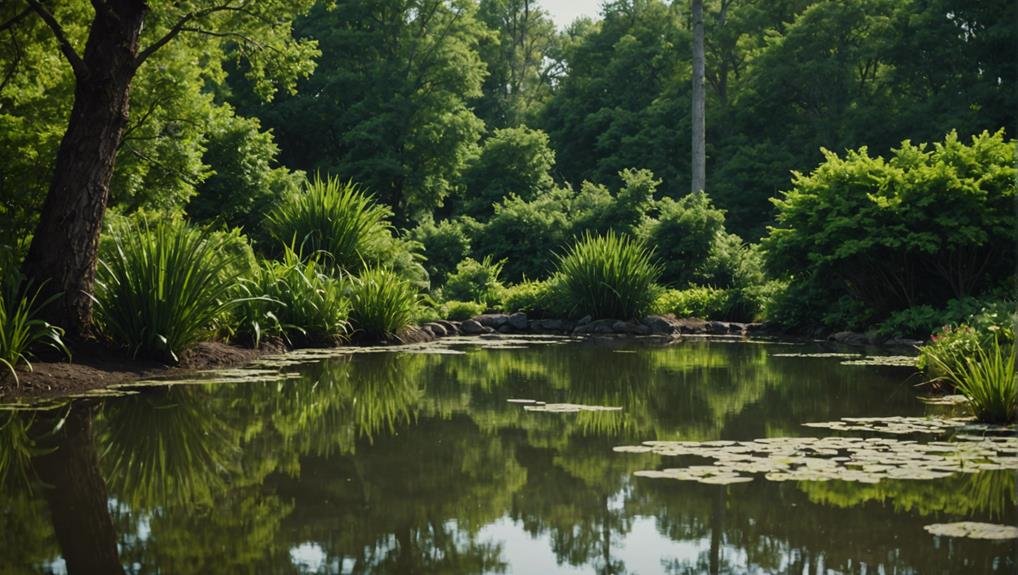Enhance your pond ecosystem by choosing shrubs that not only beautify but also support environmental well-being. Opt for Juniper and Bay Laurel for year-round foliage and structural appeal along the pond edges. For vibrant colors and wildlife attraction, consider Winterberry, Buttonbush, and Dogwood, while Spicebush and Swamp Rose promote biodiversity in moist areas. Using native shrubs aids local ecosystems, preventing erosion and enhancing water quality, while steering clear of invasives like Purple Loosestrife is crucial. Proper planting methods involving organic materials and moisture control are vital for success in creating a thriving pond paradise.
Evergreen Shrubs
Evergreen shrubs like Juniper and Bay Laurel are excellent choices for pond edges, providing year-round foliage and structural interest. These shrubs not only enhance the beauty of pond landscaping but also offer practical benefits. Juniper, with its needle-like leaves and various shades of green, is resilient to drought and adaptable to different soil types. Bay Laurel, known for its aromatic leaves, adds a touch of sophistication and can be pruned into different shapes. These evergreen shrubs maintain their foliage throughout the year, ensuring that pond edges stay lush and vibrant, even in the winter months. Additionally, they play a vital role in erosion control and provide habitats for local wildlife, promoting a balanced ecosystem in pond environments.
Additional Pond Shrubs
Winterberry, Buttonbush, and Dogwood are wonderful choices for enhancing pond edges with bursts of color and providing support for local wildlife. Winterberry (Ilex verticillata) stands out with its vibrant red berries during the winter months, attracting birds and adding seasonal charm. Buttonbush (Cephalanthus occidentalis) acts as a magnet for pollinators like bees and butterflies due to its unique spherical flowers. Dogwood (Cornus spp.) brings elegance to pond areas with its beautiful spring blossoms and striking fall foliage. Spicebush (Lindera benzoin) and Swamp Rose (Rosa palustris) are also excellent options, known for their fragrant blooms and ability to thrive in moist environments. These shrubs not only beautify the pond surroundings but also play a vital role in supporting a diverse ecosystem, fostering biodiversity and ecological harmony.
Invasive Species Concerns

Enhancing pond edges with native shrubs can significantly benefit local ecosystems; however, it is crucial to stay alert to the threat of invasive species. These species can have a significant impact by outcompeting native plants and reducing biodiversity. To maintain ecological balance, it is essential to implement prevention strategies such as monitoring and early detection. Control measures like mechanical removal and herbicide use can effectively manage invasive species.
Here are some examples of invasive species, their impact on ecosystems, and control measures:
- Purple Loosestrife: This species reduces biodiversity. Control measures include mechanical removal and herbicide application.
- Japanese Knotweed: Known for eroding soil, this species can be managed through mechanical removal and the use of root barriers.
- Hydrilla: Disrupting water flow, this species can be controlled using herbicides and biological control methods.
Benefits of Pond Shrubs
Pond shrubs offer a range of benefits, serving as vital habitats for wildlife, enhancing the beauty of the area, preventing erosion, improving water quality, and supporting biodiversity. These shrubs are crucial components of pond ecosystems, attracting various wildlife species and helping to prevent soil erosion. They also play a key role in maintaining water quality by filtering pollutants and stabilizing the pond's ecosystem.
Here are three main advantages of pond shrubs:
- Wildlife Habitat: Shrubs provide homes for birds, insects, and amphibians, creating a diverse ecosystem.
- Erosion Control: Their roots keep the soil stable, reducing erosion and sedimentation in the water.
- Aesthetic Appeal: Carefully placed shrubs enhance the visual appeal of pond areas, creating tranquil landscapes.
Planting Techniques

For successful growth of pond shrubs, it's crucial to follow effective planting techniques. Start by preparing the soil well with organic matter to improve fertility and drainage. Maintain consistent moisture levels without causing waterlogging. Dig holes twice the size of the shrub's root ball to allow for proper root spread. Ensure adequate spacing between shrubs for their mature growth. Mulching is beneficial to retain soil moisture and prevent weed growth; apply a 3-inch layer of organic mulch around the base. Regular pruning is essential to remove dead or diseased branches and encourage healthy growth. By following these steps and providing diligent care, your pond-edge shrubs will flourish, enhancing the ecosystem's health and visual appeal.
Conclusion
Introducing shrubs like juniper, camellia, rosemary, and winterberry along pond edges brings valuable ecological advantages such as providing habitats, controlling erosion, and improving water quality. This article offers practical strategies for managing invasive species to maintain a harmonious ecosystem. By understanding the unique needs of each shrub variety, it is possible to create a sustainable and flourishing pond environment that enhances both visual appeal and ecological well-being.

